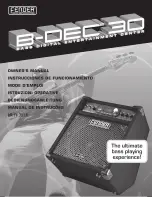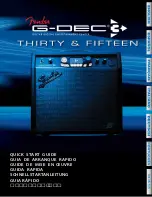
ENGLISH
1. POWER INLET
The supplied mains power lead is connected here.
The mains input voltage rating that your amplifier
has been built for is shown on the rear panel.
Warning:
before powering on, ensure the
amp is compatible with the mains voltage of
the country that the amp is being used in. If
you have any doubt, please get advice from a
qualified person.
2. MAINS FUSE
Protects the amplifier and mains supply in the
event of a fault. The correct value of mains fuse
is specified on the rear panel.
SERIAL/ PARALLEL FX LOOP:
This is a programmable FX loop located after
the pre-amp, right before the reverb and serial
loop circuits. The FX Loop switch engages/
disengages this effects loop.
13. SERIAL / PARALLEL FX LOOP: SEND
Connect your external FX equipment here
using a ¼” jack instrument cable.
12. SERIAL / PARALLEL FX LOOP: RETURN
Return your signal from external FX equipment
here using a ¼” jack instrument cable.
11. SERIAL / PARALLEL FX LOOP: FX LEVEL
Configure the loop for use with either
professional equipment (+4dBu setting) or with
guitar level effects like effects pedals (-10dBV
setting).
10. SERIAL / PARALLEL FX LOOP: MIX
CONTROL
Control the amount of effect that can be dialled
in with the mix control. When mix is set to ‘wet’,
all the signal goes through the external loop,
adding more direct (unprocessed) signal as you
turn it towards dry.
Note:
if you do not connect any effect to the
serial/parallel effects loop the mix control can
be used to act like an extra volume control in
any of the channels.
Warning:
when mixing the wet and dry
signals the external effects processor’s output
should be configured to remove the direct
(unprocessed) signal. If the amp sounds thin
after connecting an external effect check that
no direct signal is being returned from the
processor’s output.
Note:
if the FX loop is on and the mix control
is set to wet without an external processor
connected, the amplifier will be muted.
ADVANCED USES OF THE SERIAL/PARALLEL
EFFECTS LOOP
•
To have a tuner output muting the amplifier,
connect the tuner to the FX send and select
the clean channel. Turn the mix control to
wet and switch the FX loop on. Store this
preset and label it for example as ‘tuner’.
With this configuration it is not possible to
connect any other effect to the loop.
•
As the JVM reverb circuitry is connected
after the parallel loop you can create
presets that affect an external preamp,
including reverb and/or selecting a
different master volume.
•
To use a different preamplifier and
combine it with the JVM channels:
1. Connect the external preamplifier output
to the parallel loop return and turn the mix
to wet.
2. Connect the external preamp input with a
splitter to the amplifiers input.
POWER AMP INSERT / SERIAL LOOP
This is a passive loop connected right before
the master controls. It is a line level loop so it
is recommended to only use high headroom
devices to avoid signal degradation.
9. PRE-AMP OUT / SEND
Connect your external FX equipment here
using a ¼” jack instrument cable.
8. POWER-AMP IN / RETURN
Return your signal from external FX equipment
here using a ¼” jack instrument cable.
Note:
you can plug an external preamp into this
return jack to override the JVM preamp section
and use the power section only. The master
controls and the emulated line out are located
after the serial loop so it is still possible to use
those features when using an external preamp.
Note:
to use 2 heads simultaneously, the
suggested procedure is to:
1. Connect the ‘master’ head pre-amp out to
the ‘slave’ head power-amp in.
2. Switch the power-amp insert to active in
the ‘slave’ amplifier.
In order to track the master volume settings in
both heads it is suggested to use MIDI control
with both amplifiers programmed in the same
way. Connect the MIDI in of one of the amps to
the MIDI thru of the other and the pedalboard
or MIDI equipment to the remaining MIDI in.
4.1
REAR PANEL FUNCTIONS
CONTINUED
Summary of Contents for JVM 4 Series
Page 1: ...JVM 4 SERIES USER MANUAL...
Page 16: ...JVM 4 SERIES MANUEL D UTILISATION...
Page 31: ...JVM 4 SERIES BENUTZERHANDBUCH...
Page 45: ...JVM 4 SERIES MANUAL DEL USUARIO...
Page 59: ...JVM 4 SERIES...
Page 60: ...JVM JVM JVM STOMPWARE MARSHALL 61 62 63 66 MIDI 69 70 71...
Page 61: ...1 2 0 3 4 5 6 7 Marshall 1 2 3 4 5 6 1 0...
Page 65: ...3 2 14 11 OD1 OD1 12 OD2 OD2 1 2 5 1 1 6 2 2 2 7 1 2 LED 2 1 1 2 9 8...
Page 67: ...4 1 1 2 13 12 11 4dBu 10dBV 10 JVM JVM 1 2 9 8 JVM 1 2 MIDI MIDI MIDI MIDI 7 6 4x12...
Page 68: ...4 2 5 14 1 4 1 x 16 Ohm 16 1 x 8 Ohm 2 x 16 Ohm 8 16 1 x 4 Ohm 2 x 8 Ohm 4 8...
Page 71: ...7 0 MIDI MIDI MIDI 1 1 2 3 2 LED 4 5 1 2 6 3 4 LED 5 5 1 4 6 1 2 3 OD1 4 OD2 5 6...
Page 73: ...JVM 4 SERIES...
Page 74: ...JVM JVM 3 STOMPWARE 75 76 77 80 MIDI 83 84 85...
Page 75: ...1 2 3 4 5 6 7 1 2 3 4 5 6 1 0...
Page 80: ...4 0 2 4 3 5 7 8 9 10 11 12 13 14 6 1 JVM410C 2 3 4 5 6 7 8 9 10 11 12 13 14 1 JVM410H...
Page 81: ...4 1 1 2 13 12 11 4dBu 10dBV 10 JVM JVM 1 2 9 8 JVM...











































